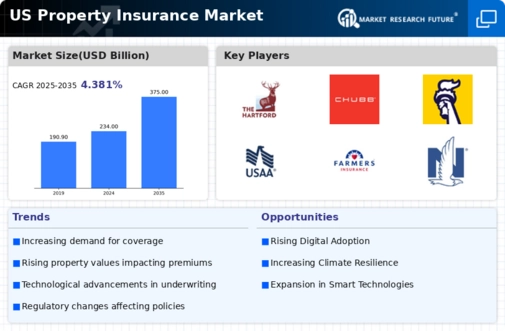The US Property Insurance Market is characterized by a diverse array of companies competing for market share across various segments such as homeowners insurance, renters insurance, and commercial property insurance. The competitive landscape includes large multinational insurers as well as smaller regional players, each striving to differentiate their offerings in an ever-evolving environment marked by shifting regulatory frameworks and changing consumer expectations.
Factors such as technology integration, customer service, pricing strategies, and claims handling efficiency are essential in determining the competitive position of these insurers. As the market faces challenges from natural disasters, climate change, and increasing repair costs, understanding the competitive dynamics becomes crucial for stakeholders in the industry, including consumers, investors, and policymakers.
The Hartford has established a notable presence in the US Property Insurance Market, leveraging its long-standing reputation and comprehensive service offerings. The company is recognized for its tailored insurance solutions that cater to both personal and commercial customers, showcasing robust strengths in underwriting, risk assessment, and claims management.
Additionally, The Hartford has effectively embraced digital transformation, employing advanced technology to streamline its processes and enhance customer engagement. This focus on customer-centric service is complemented by the company's financial health, allowing for a competitive advantage in pricing and product development. The Hartford continues to invest in innovative insurance products, which resonate well with evolving consumer needs and preferences while maintaining a solid foothold in the market through strategic partnerships and alliances.Cincinnati Financial has carved out a significant niche in the US Property Insurance Market, particularly known for its strong emphasis on superior customer service and community engagement.
The company offers a range of property insurance products, including homeowners and commercial property coverage, that are designed to meet the specific needs of its clientele. Cincinnati Financial's strengths lie in its well-established distribution network through independent agents, ensuring personalized service and localized expertise.
The company also has a solid history of profitability and financial stability, allowing it to be agile in its responses to market dynamics. Significant mergers and acquisitions have also bolstered Cincinnati Financial's market position, expanding its product offerings and geographical reach while enhancing its capabilities in claims management and customer service. Overall, the company remains committed to sustaining its competitive edge through innovation and a focus on long-term relationships with policyholders.





















